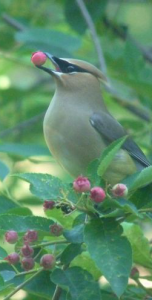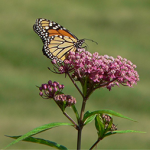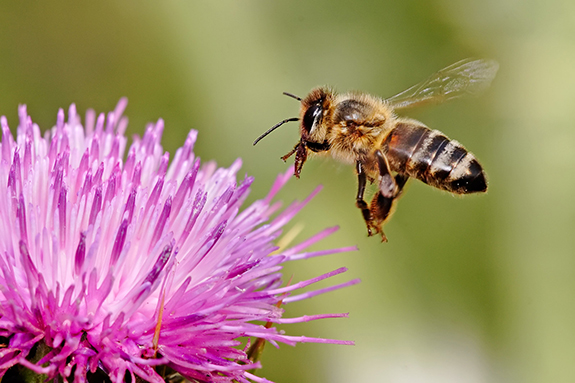Every Effort is Making a Difference
Support our native pollinators! Essential to our own survival, pollinators are responsible for approximately one out of every three bites we eat! Pollinators are in decline, but our efforts can make a difference in their repopulation.
According to University of Delaware entomology professor Doug Tallamy, anyone with access to a patch of earth can make a significant contribution toward sustaining biodiversity. His landmark book Bringing Nature Home explains the findings from his research and gives practical guidance on how we can help restore nature, even on the smallest scale.
Together, We Can Restore Pollinators’ Populations
The good news is that it’s within our power to help turn things around with the plants we choose to grow in our own backyard… or front yard or apartment balcony. And his research tells us that it’s working.

Cedar Wax Wing eating service berries.
“For the first time in its history, gardening has taken on a role that transcends the needs of the gardener. Like it or not, gardeners have become important players in the management of our nation’s wildlife. It is now within the power of individual gardeners to do something that we all dream of doing: to make a difference. In this case, the ‘difference’ will be to the future of biodiversity, to the native plants and animals of North America and the ecosystems that sustain them.
— Douglas Tallamy, Bringing Nature Home
It’s so simple! Native plants attract and sustain native wildlife, including the native insects that many of our wild birds eat to survive. As wild bird hosts who conscientiously stock feeders and keep water accessible, this presents another great opportunity to lure new visitors to our yards!
Professor Tallamy‘s entertaining and educational book, and the book’s companion website, BringingNatureHome.net, are highly recommended for further reading. Not only about the science behind his studies, or the limitless benefits and positive repercussions from making simple changes in your landscape, but also for inspiration and a plan of action.
Replace a non-native or invasive plant in your yard with a native! For help with specific plants for our area, we’ve listed several links below to help you get started — just a few of the many, many local resources available.
For example, planting even ONE stand of the right milkweed can contribute to Monarch Butterfly conservation. (See our blog post “Grow Native Milkweed for Monarch Butterflies”.)
Every Day is Earth Day at The Backyard Naturalist!
We are proud that our Backyard Naturalist community celebrates Earth Day every day with steadfast, year round support for our wild birds. Collectively, our efforts to create these micro-sanctuaries are making a difference!
Together, we are helping repopulate plants and add diversity to our environment. This makes our ecosystem more resilient and strengthens populations of pollinators in decline.
Almost 30 years ago, a vision of our own little backyard wildlife habitat connected with those of our friends, neighbors, and customers—and millions of backyards across the country—inspired us to open The Backyard Naturalist store. Please share this with your friends and neighbors and take time to enjoy and celebrate your ‘patch of earth’ on Earth Day—and EVERY Day.
Where to Start & How You Can Help Native Pollinators
We can’t say it any better than the folks at Botanical Interests. Follow their ‘Four “P”s of Pollinator-Friendly Gardening’:
- Plant flowers: Provide food for pollinators by sowing flowers, especially native varieties.
- Plant diversity: Plant a diversity of bloom times, colors, and heights. By staggering bloom times, you provide a reason for pollinators to call your garden home throughout the growing season. Some pollinators are very small and need very small, open flowers in order to access the pollen or nectar. Sow a diversity of flower shapes and sizes, usually simpler (vs. double petal) varieties of flowers work for more species.
- Provide water: In your water feature, create small islands with stones where pollinators can land, and climb in and out.
- Pass on pesticides: Look for organic ways to block pests, disrupt their life cycle, and invite their predators. Integrated Pest Management (IMP) techniques utilize simpler solutions, such as using a fabric row cover to block pests. Sowing varieties like alyssum or allowing dill to flower, both attract beneficial and predatory insects. Is your yard healthy for YOU? The Great Healthy Yard Project
Regional Native Plant Information and Sources
Audubon’s Native Plant Database is a mighty resource! Enter your zip code and you’ll get a list of best native plants for supporting the wild birds your area, as recommended by local Audubon experts. You can sort results by type of plant and also by type of bird you’d like to attract.

A simple stand of native milkweed can make every backyard, school, community center, city park and place of worship a haven for breeding or migrating Monarchs, and together we can bring about the greatest citizen conservation victory of our generation.
Dan Ashe, Director
The US Fish & Wildlife Service
Maryland
University of Maryland Extension Home and Garden Information Center
Recommended Native Plants of Maryland
Virginia
Virginia’s Department of Conservation and Recreation’s Division of Natural Heritage (DCR)
Mid-Atlantic Region






